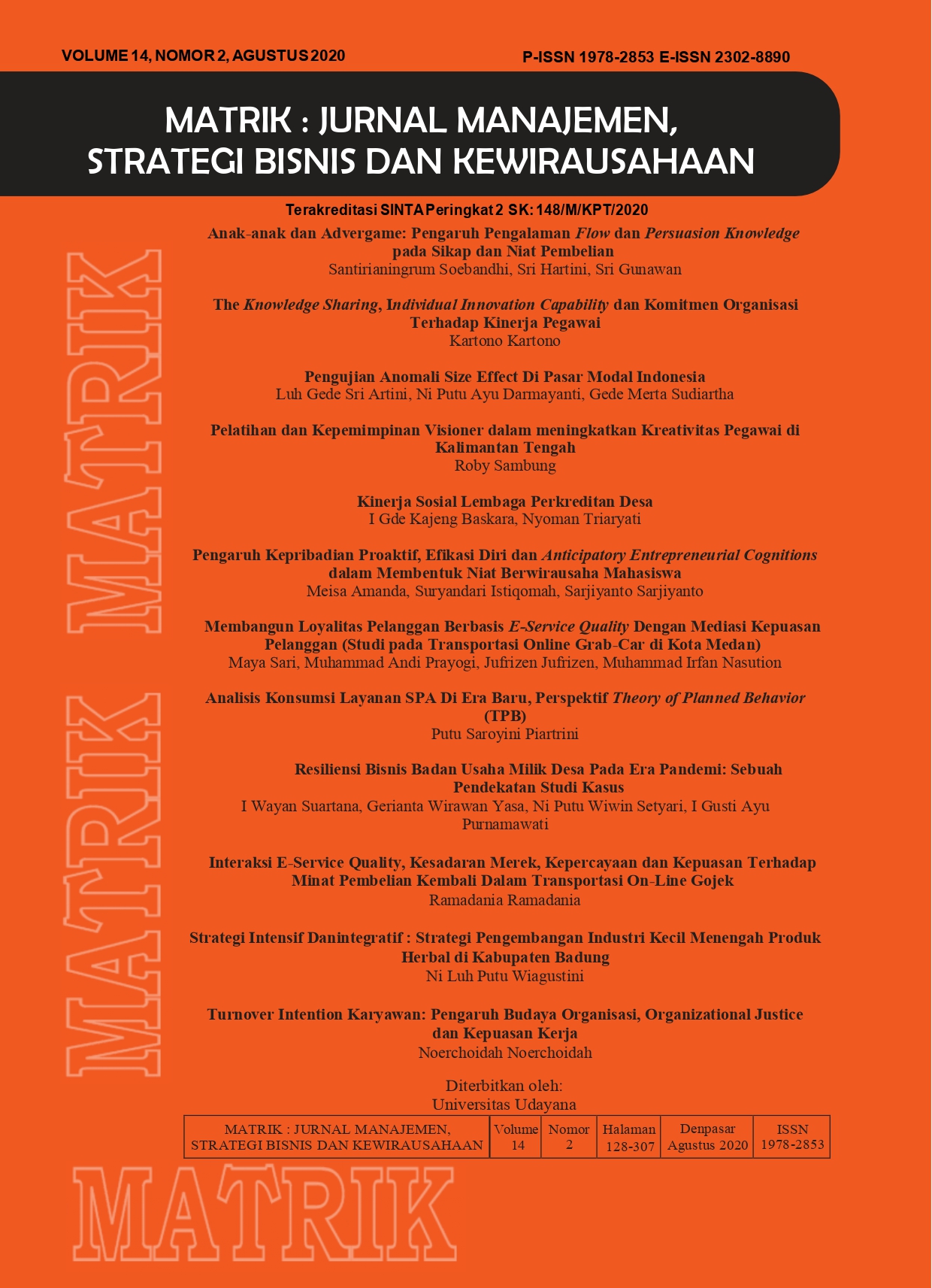Analisis Konsumsi Layanan SPA Di Era Baru, Perspektif Theory of Planned Behavior (TPB)
Abstract
Present study predict intention to engage in SPA in Post Pandemi situation from Planned Behavior Theory, extended with Perceived Risk as predictors. Data were accumulated from 390 SPA customers who engaged in SPA treatment in Kuta and Ubud as main destination of foreign visitors. data analysis uncovered that attitude, subjective norms , perceived behavioral control and perceived risk significantly affected intention to engage in SPA treatment. to encourage intention to engage in SPA treatment provider needs to implement health and security procedures consistently because higher perceived risk will lessen intention to engage in SPA treatment.
Downloads
References
Ajzen, I. (1991). The Theory of Planned Behavior Organizational Behavior and Human Decision Processes. Organizational Behavior and Human Decision Processes, 50(2), 179–211.
Allen, M. W., Hung Ng, S., & Wilson, M. (2002). A functional approach to instrumental and terminal values and the value‐attitude‐behaviour system of consumer choice. European Journal of Marketing, 36(1/2), 111–135. https://doi.org/10.1108/03090560210412728
Átha Cliath, B. (2011). “Consumer Attitude toward Spa in Thailand.” Malardalen University Sweden, 06(June), 52–54.
Ayob, S. F., Sheau-Ting, L., Abdul Jalil, R., & Chin, H. C. (2017). Key determinants of waste separation intention: empirical application of TPB. Facilities, 35(11–12), 696–708. https://doi.org/10.1108/F-06-2016-0065
Ayuningtyas, A. F., Widyatmaja, I. G. N., & Sulistyawati, A. S. (2019). Strategi Pemasaran Untuk Meningkatkan Tingkat Penjualan Produk di Sang Spa Ubud Bali. 3(1), 195–210.
Bartle, N. C., & Harvey, K. (2017). Explaining infant feeding: The role of previous personal and vicarious experience on attitudes, subjective norms, self-efficacy, and breastfeeding outcomes. British Journal of Health Psychology, 22(4), 763–785. https://doi.org/10.1111/bjhp.12254
Bettman, J. R. (1979). Information processing theory of consumer choice. Addison-Wesley Pub. Co..
Bidin, Z., Deraman, M. J., & Othman, M. Z. (2016). the Realtionships Among Attitude , Subjective Norm and. December, 1–7.
Bitner, M. J., Booms, B. H., & Tetreault, M. S. (1990). The Service Encounter : Diagnosing Favorable and. 54(January), 71–84.
Chen, Z., Lan, Y., & Zhao, R. (2018). Impacts of risk attitude and outside option on compensation contracts under different information structures. Fuzzy Optimization and Decision Making, 17(1), 13–47. https://doi.org/10.1007/s10700-016-9263-7
Cui, F., Liu, Y., Chang, Y., Duan, J., & Li, J. (2016). An overview of tourism risk perception. Natural Hazards, 82(1), 643–658. https://doi.org/10.1007/s11069-016-2208-1
Dahiya, R., & Gayatri. (2017). Investigating Indian Car Buyers’ Decision to Use Digital Marketing Communication: An Empirical Application of Decomposed TPB. Vision, 21(4), 385–396. https://doi.org/10.1177/0972262917733175
Dowling, G. R., & Staelin, R. (1994). A Model of Perceived Risk and Intended Risk-Handling Activity. Journal of Consumer Research, 21(1), 119. https://doi.org/10.1086/209386
Geng, L., Liu, T., Zhou, K., & Yang, G. (2018). Can power affect environmental risk attitude toward nuclear energy? Energy Policy, 113(March), 87–93. https://doi.org/10.1016/j.enpol.2017.10.051
Ha, N. T. (2020). The impact of perceived risk on consumers’ online shopping intention: An integration of TAM and TPB. Management Science Letters, 10(9), 2029–2036. https://doi.org/10.5267/j.msl.2020.2.009
Herek, G. (1987). Religious Orientation and Prejudice: A Comparison of Racial and Sexual Attitudes. Personality and Social Psychology Bulletin, 13(1), 34–44. https://doi.org/10.1177/0146167287131003
Ho, S. M., Ocasio-Velázquez, M., & Booth, C. (2017). Trust or consequences? Causal effects of perceived risk and subjective norms on cloud technology adoption. Computers and Security, 70, 581–595. https://doi.org/10.1016/j.cose.2017.08.004
Hsieh, C. M., Park, S. H., & McNally, R. (2016). Application of the Extended Theory of Planned Behavior to Intention to Travel to Japan Among Taiwanese Youth: Investigating the Moderating Effect of Past Visit Experience. Journal of Travel and Tourism Marketing, 33(5), 717–729. https://doi.org/10.1080/10548408.2016.1167387
Jafarkarimi, H., Saadatdoost, R., Sim, A. T. H., & Hee, J. M. (2016). Behavioral intention in social networking sites ethical dilemmas: An extended model based on Theory of Planned Behavior. Computers in Human Behavior, 62, 545–561. https://doi.org/10.1016/j.chb.2016.04.024
Jin, N. (Paul), Line, N. D., & Merkebu, J. (2016). The Impact of Brand Prestige on Trust, Perceived Risk, Satisfaction, and Loyalty in Upscale Restaurants. Journal of Hospitality Marketing and Management, 25(5), 523–546. https://doi.org/10.1080/19368623.2015.1063469
Johe, M. H., & Bhullar, N. (2016). To buy or not to buy: The roles of self-identity, attitudes, perceived behavioral control and norms in organic consumerism. Ecological Economics, 128, 99–105. https://doi.org/10.1016/j.ecolecon.2016.02.019
Kamalul Ariffin, S., Mohan, T., & Goh, Y. N. (2018). Influence of consumers’ perceived risk on consumers’ online purchase intention. Journal of Research in Interactive Marketing, 12(3), 309–327. https://doi.org/10.1108/JRIM-11-2017-0100
Khalek, A. A., & Ismail, S. H. S. (2015). Why Are We Eating Halal – Using the Theory of Planned Behavior in Predicting Halal Food Consumption among Generation Y in Malaysia. International Journal of Social Science and Humanity, 5(7), 608–612. https://doi.org/10.7763/ijssh.2015.v5.526
Kim, E., Ham, S., Yang, I. S., & Choi, J. G. (2013). The roles of attitude, subjective norm, and perceived behavioral control in the formation of consumers’ behavioral intentions to read menu labels in the restaurant industry. International Journal of Hospitality Management, 35, 203–213. https://doi.org/10.1016/j.ijhm.2013.06.008
Lacey, S., Bruwer, J., & li, E. (2009). The role of perceived risk in wine purchase decisions in restaurants. International Journal of Wine Business Research, 21(2), 99–117. https://doi.org/10.1108/17511060910967962
Lim, Y. J., Kim, H. K., & Lee, T. J. (2016). Visitor Motivational Factors and Level of Satisfaction in Wellness Tourism: Comparison Between First-Time Visitors and Repeat Visitors. Asia Pacific Journal of Tourism Research, 21(2), 137–156. https://doi.org/10.1080/10941665.2015.1029952
Lin, C. Y., Updegraff, J. A., & Pakpour, A. H. (2016). The relationship between the theory of planned behavior and medication adherence in patients with epilepsy. Epilepsy and Behavior, 61, 231–236. https://doi.org/10.1016/j.yebeh.2016.05.030
Loureiro, S. M. C., Almeida, M., & Rita, P. (2013). The effect of atmospheric cues and involvement on pleasure and relaxation: The spa hotel context. International Journal of Hospitality Management, 35, 35–43. https://doi.org/10.1016/j.ijhm.2013.04.011
Lu, C. Y., Yeh, W. J., & Chen, B. T. (2016). The Study of International Students’ Behavior Intention for Leisure Participation: Using Perceived Risk as a Moderator. Journal of Quality Assurance in Hospitality and Tourism, 17(2), 224–236. https://doi.org/10.1080/1528008X.2015.1115267
Lu, I. Y., & Shiu, J. Y. (2011). Decision-making framework of customer perception of value in Taiwanese spa hotels. Social Behavior and Personality, 39(9), 1183–1192. https://doi.org/10.2224/sbp.2011.39.9.1183
Mak, A. H. N., Wong, K. K. F., & Chang, R. C. Y. (2009). Health or self‐indulgence_ The motivations and characteristics of spa‐goers (PDF Download Available).pdf. 199(December 2008), 185–199.
Marakanon, L., & Panjakajornsak, V. (2017). Perceived quality, perceived risk and customer trust affecting customer loyalty of environmentally friendly electronics products. Kasetsart Journal of Social Sciences, 38(1), 24–30. https://doi.org/10.1016/j.kjss.2016.08.012
Martínez Caro, L., & Martínez García, J. A. (2008). Developing a multidimensional and hierarchical service quality model for the travel agency industry. Tourism Management, 29(4), 706–720. https://doi.org/10.1016/j.tourman.2007.07.014
McEachan, R., Taylor, N., Harrison, R., Lawton, R., Gardner, P., & Conner, M. (2016). Meta-Analysis of the Reasoned Action Approach (RAA) to Understanding Health Behaviors. Annals of Behavioral Medicine, 50(4), 592–612. https://doi.org/10.1007/s12160-016-9798-4
Mitchell, V. W., & Greatorex, M. (1988). Consumer Risk Perception in the UK Wine Market. European Journal of Marketing, 22(9), 5–15. https://doi.org/10.1108/EUM0000000005296
Nduneseokwu, C. K., Qu, Y., & Appolloni, A. (2017). Factors influencing consumers’ intentions to participate in a formal e-waste collection system: A case study of Onitsha, Nigeria. Sustainability (Switzerland), 9(6), 1–17. https://doi.org/10.3390/su9060881
Noone, B. M., & Mattila, A. S. (2009). Consumer reaction to crowding for extended service encounters. Managing Service Quality, 19(1), 31–41. https://doi.org/10.1108/09604520910926791
Olson, M. A., & Fazio, R. H. (2001). Implicit attitude formation through classical conditioning. Psychological Science, 12(5), 413–417. https://doi.org/10.1111/1467-9280.00376
Ozturk, A. B., Nusair, K., Okumus, F., & Singh, D. (2017). Understanding mobile hotel booking loyalty: an integration of privacy calculus theory and trust-risk framework. Information Systems Frontiers, 19(4), 753–767. https://doi.org/10.1007/s10796-017-9736-4
Park, S. (2013). Multidimensional Facets of Perceived Risk in Mobile Travel Booking. Journal of Petrology, 369(1), 1689–1699. https://doi.org/10.1017/CBO9781107415324.004
Ross, M. W., & Mclaws, M. L. (1992). Subjective norms about condoms are better predictors of use and intention to use than attitudes. Health Education Research, 7(3), 335–339. https://doi.org/10.1093/her/7.3.335
Seth, N., Deshmukh, S. G., & Vrat, P. (2005). Service quality models: A review. In International Journal of Quality and Reliability Management (Vol. 22, Issue 9). https://doi.org/10.1108/02656710510625211
Sheth, J. N., & Venkatesan, M. (1968). Risk-Reduction Processes in Repetitive Consumer Behavior. Journal of Marketing Research, 5(3), 307. https://doi.org/10.2307/3150350
Sobh, R., & Martin, B. A. S. (2011). Feedback information and consumer motivation. European Journal of Marketing, 45(6), 963–986. doi:10.1108/03090561111119976
Szromek, A. R., & Naramski, M. (2019). A business model in spa tourism enterprises: Case study from Poland. Sustainability (Switzerland), 11(10). https://doi.org/10.3390/su11102880
Unless, R., Act, P., Rose, W., If, T., & Rose, W. (2016). The Intention–Behavior Gap. Social and Personality Psychology Compass. The University of Sheffield, 10(9), 503–518.
Vryoni, S., Bakirtzoglou, P., & Ioannou, P. (2017). Customers’ Satisfaction and Service Quality of Spa Centers in Greece. Acta Kinesiologica, 11(January), 12–18.
Wellness, G. (2018). Asia-Pacific. November.
Yeo, V. C. S., Goh, S. K., & Rezaei, S. (2017). Consumer experiences, attitude and behavioral intention toward online food delivery (OFD) services. Journal of Retailing and Consumer Services, 35(July 2016), 150–162. https://doi.org/10.1016/j.jretconser.2016.12.013
 This work is licensed under a Creative Commons Attribution-ShareAlike 4.0 International License.
This work is licensed under a Creative Commons Attribution-ShareAlike 4.0 International License.

















